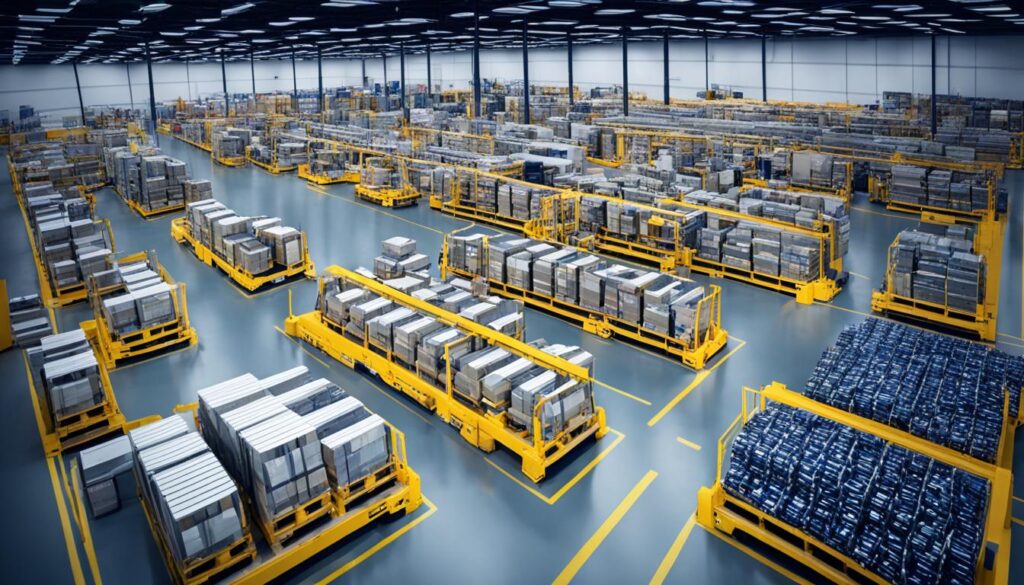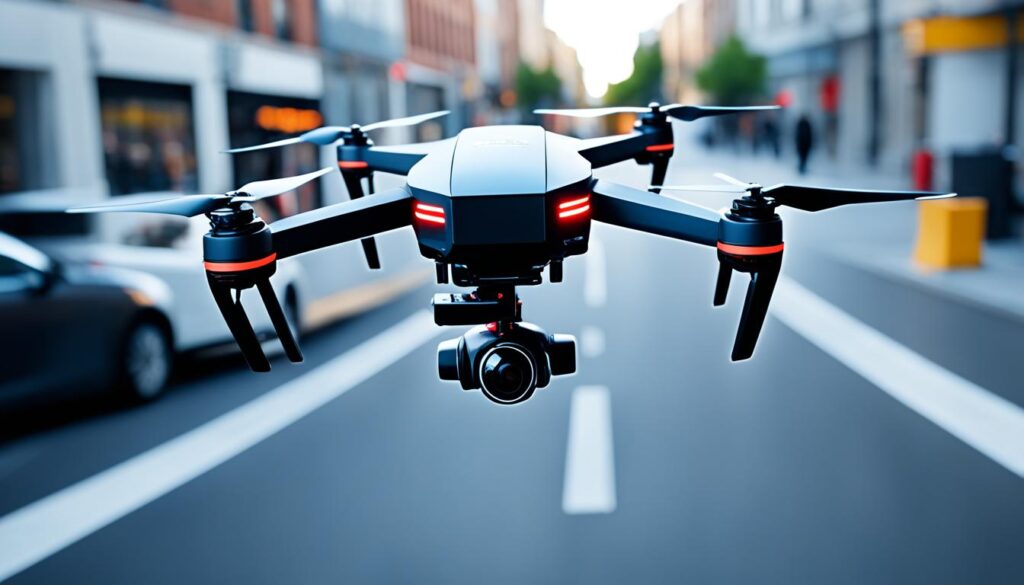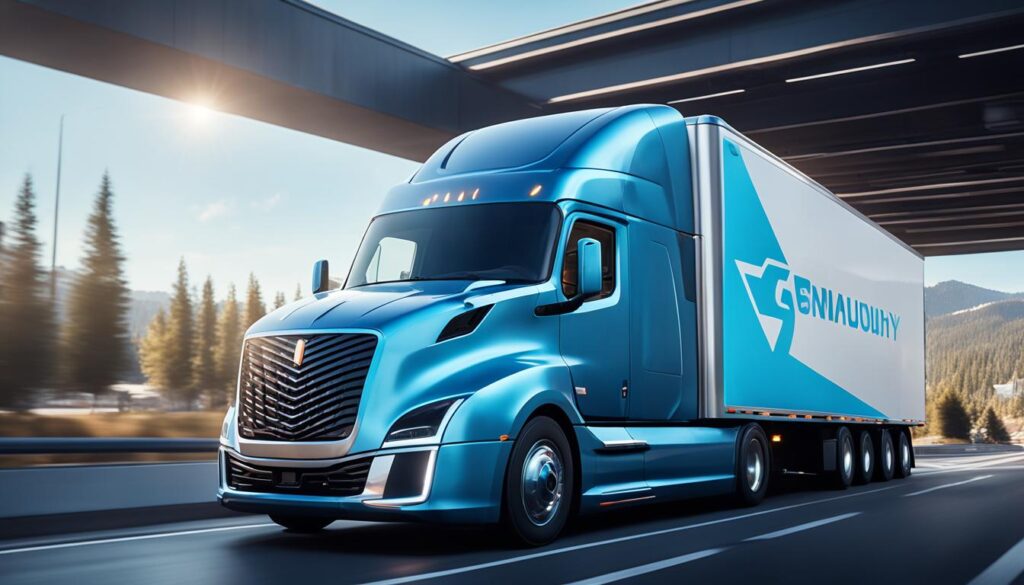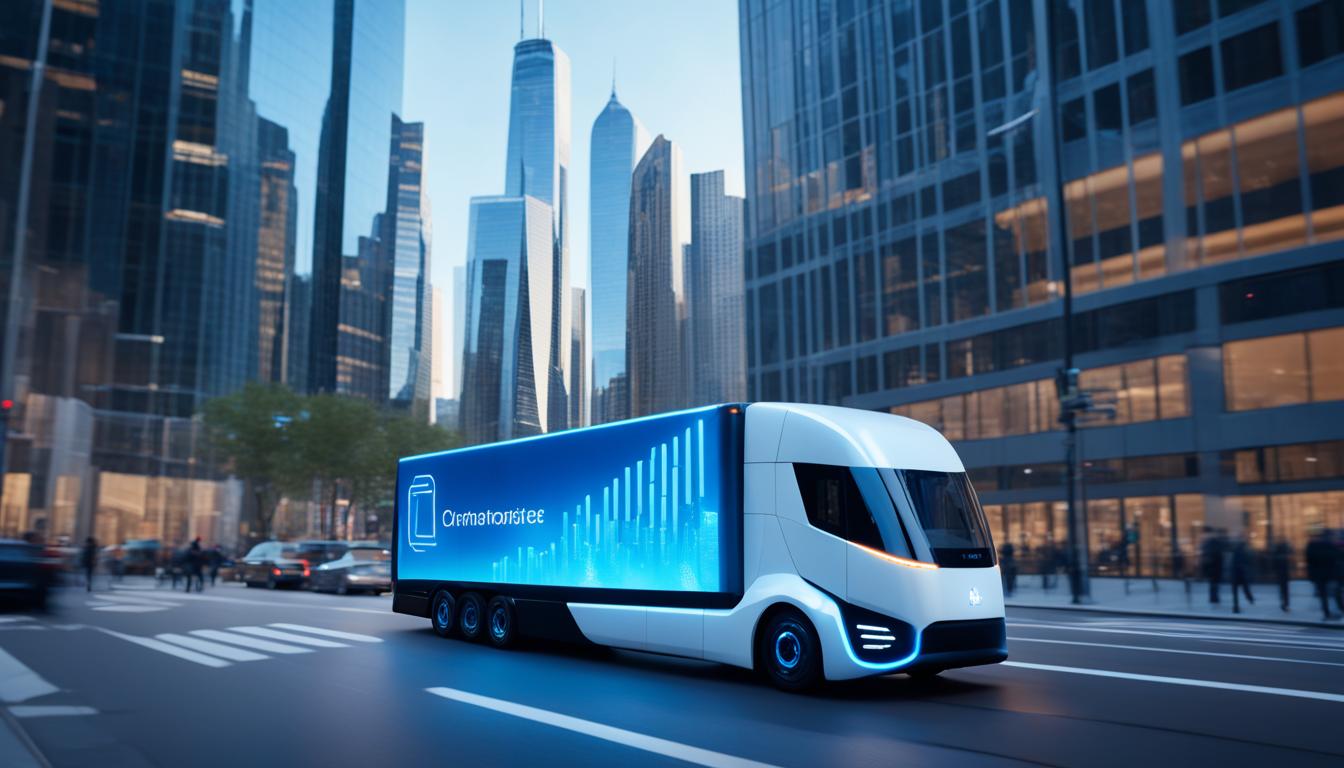Artificial Intelligence (AI) is transforming the delivery industry, bringing about a revolution in logistics and supply chain operations. From optimizing delivery routes to automating warehouse processes, AI is reshaping how products are delivered to customers. This technology is driving efficiency, enhancing customer experiences, and paving the way for the future of delivery services.
AI algorithms enable businesses to optimize delivery routes, accurately forecast demand, automate inventory management, and improve overall operational efficiency. By harnessing the power of AI, companies like Amazon, Walmart, FedEx, and UPS are revolutionizing their delivery services and staying ahead in a highly competitive market.
With the integration of AI, the delivery industry benefits from smart supply chain solutions, advanced data analytics tools, and automation technologies. These innovations bring a myriad of advantages, including increased productivity, cost savings, improved safety measures, and the potential for future innovations.
Key Takeaways:
- The use of AI in logistics is transforming the delivery industry.
- AI enables optimization of delivery routes, demand forecasting, and warehouse automation.
- Companies like Amazon, Walmart, FedEx, and UPS are leveraging AI to revolutionize their delivery services.
- AI improves operational efficiency, enhances customer experiences, and ensures secure and timely deliveries.
- The integration of AI in the delivery industry offers significant competitive advantages and opens doors to future innovations.
Route Optimization
Route optimization plays a crucial role in the efficient operation of delivery services. With the help of AI algorithms, businesses can analyze real-time traffic data, weather conditions, and historical delivery data to determine the most efficient routes for their operations.
By considering various factors such as traffic congestion, road conditions, and delivery schedules, AI algorithms can generate optimized routes that result in reduced fuel consumption and shorter delivery times. This not only leads to cost savings but also improves overall operational efficiency.
Real-time traffic data allows AI algorithms to dynamically adjust delivery routes based on the current conditions, ensuring that drivers can take the fastest and most efficient paths. By taking into account weather conditions, routes can be optimized to avoid areas that may be affected by adverse weather, reducing the risk of delays or accidents.
| Benefits of Route Optimization with AI |
|---|
| Reduced Fuel Consumption |
| Shorter Delivery Times |
| Improved Operational Efficiency |
Efficient delivery operations are vital for businesses looking to meet customer expectations and gain a competitive edge in the market. The ability to optimize routes using AI algorithms allows companies to streamline their logistics processes, leading to faster, more reliable deliveries.
Moreover, by reducing fuel consumption, businesses can contribute to environmental sustainability efforts while also reducing operational costs. The shorter delivery times achieved through route optimization enable companies to provide quicker service to their customers, ultimately enhancing the overall customer experience.
In summary, by leveraging AI algorithms for route optimization, businesses can achieve more efficient delivery operations, reduced fuel consumption, and shorter delivery times. This not only benefits the bottom line but also contributes to a more sustainable and customer-centric delivery industry.
Demand Forecasting
In the world of logistics and supply chain management, accurate demand forecasting is crucial for effective inventory planning and optimized delivery schedules. This is where AI analysis comes into play, leveraging historical sales data, seasonality, and external factors to provide businesses with accurate demand forecasts.
By harnessing the power of AI algorithms, companies can gain valuable insights into customer behavior, market trends, and operational efficiencies. This enables them to make informed decisions regarding inventory levels, ensuring that they neither run the risk of stockouts nor waste resources on unnecessary overstocking.
With AI-powered demand forecasting, businesses can optimize their inventory management, streamline their supply chain operations, and ultimately meet customer demand more efficiently. This not only leads to cost savings but also enhances customer satisfaction by ensuring products are readily available when needed.
Benefits of AI-Driven Demand Forecasting:
- Accurate forecasts based on historical sales data, seasonality, and external factors
- Effective inventory planning to avoid stockouts and overstocking
- Optimized delivery schedules for improved operational efficiency
- Cost savings through reduced inventory holding costs and minimized waste
- Enhanced customer satisfaction by meeting demand with precision
“AI-driven demand forecasting enables businesses to make data-backed decisions, ensuring they meet customer demand efficiently and effectively.”
By harnessing AI analysis and leveraging historical sales data, seasonality, and external factors, businesses can accurately forecast demand, allowing them to optimize their inventory planning, streamline their delivery operations, and ultimately stay ahead in today’s competitive market.
Take a look at the table below for a comprehensive overview of the benefits of AI-driven demand forecasting:
| Benefits of AI-Driven Demand Forecasting | |
|---|---|
| Accurate forecasts based on historical sales data, seasonality, and external factors | |
| Effective inventory planning to avoid stockouts and overstocking | |
| Optimized delivery schedules for improved operational efficiency | |
| Cost savings through reduced inventory holding costs and minimized waste | |
| Enhanced customer satisfaction by meeting demand with precision |

Warehouse Automation
Warehouse automation is revolutionizing the logistics industry by leveraging the power of AI-driven robots and autonomous vehicles. These intelligent systems are transforming the efficiency of picking, packing, and sorting processes, leading to more streamlined operations and reduced labor costs.
The use of AI-driven robots in warehouses enables the automation of repetitive tasks, such as inventory management and order fulfillment. These robots can efficiently navigate the warehouse, locate items, and pack them accurately, contributing to faster and more efficient delivery operations.
Autonomous vehicles, on the other hand, play a crucial role in optimizing the movement of goods within the warehouse. They can transport items from one location to another, eliminating the need for manual transportation and reducing the reliance on human labor. This not only improves operational efficiency but also enhances safety within the warehouse environment.
Efficient picking, packing, and sorting processes are vital for meeting customer demands in a timely manner. By incorporating AI-driven robots and autonomous vehicles, warehouses can optimize these processes, ensuring that orders are fulfilled quickly and accurately.
The benefits of warehouse automation extend beyond efficient operations and reduced labor costs. By leveraging AI technologies, warehouses can also improve inventory management, minimize errors, and enhance overall supply chain visibility.
Warehouse automation has already proven its effectiveness in renowned companies such as Amazon and Alibaba, where AI-driven robots and autonomous vehicles have significantly contributed to their success in the e-commerce sector.
“Warehouse automation powered by AI-driven robots and autonomous vehicles is transforming the logistics industry, enabling faster order fulfillment, reduced labor costs, and improved customer satisfaction.”
Advantages of Warehouse Automation
- Efficient picking, packing, and sorting processes
- Reduced labor costs
- Improved accuracy and minimized errors
- Enhanced supply chain visibility
- Faster order fulfillment
- Increased safety and warehouse optimization

Warehouse Automation Examples
| Company | AI-Driven Robots/Autonomous Vehicles | Benefits |
|---|---|---|
| Amazon | Robots for picking, packing, and sorting | Improved operational efficiency |
| Alibaba | Autonomous vehicles for goods transportation | Streamlined warehouse operations |
| UPS | Robotic sorting systems | Efficient package routing |
Last-Mile Delivery Optimization
AI is revolutionizing last-mile delivery by leveraging advanced technologies such as autonomous vehicles, drones, and sidewalk robots. These AI-optimized solutions provide efficient and innovative delivery methods, enhancing the overall delivery experience for customers.
Autonomous vehicles, equipped with AI algorithms, offer a cost-effective and reliable option for last-mile delivery. They can navigate through traffic, optimize routes in real-time, and ensure timely and efficient deliveries. Companies like Waymo and Tesla are at the forefront of developing autonomous vehicle solutions for last-mile delivery.
Drones are another AI-enabled delivery method that excels in delivering lightweight packages over short distances. These unmanned aerial vehicles can bypass traffic congestion and traverse challenging terrains, improving delivery speed and accessibility. Industry giants like Amazon and UPS have already begun testing drone delivery services.
Sidewalk robots are increasingly being deployed for last-mile deliveries in urban areas. These compact and AI-driven robots navigate sidewalks and pedestrian pathways, ensuring quick and secure deliveries. Startups like Starship Technologies and Postmates Serve are leading the way in sidewalk robot technology.
With AI-optimized last-mile delivery methods, businesses can overcome the challenges of complex urban environments, reduce delivery times, and streamline operations. By leveraging autonomous vehicles, drones, and sidewalk robots, companies can offer efficient and convenient delivery options while enhancing customer satisfaction.
To showcase the impact of AI in last-mile delivery, let’s take a look at a comparison table:
| Delivery Method | Advantages |
|---|---|
| Autonomous Vehicles | Efficient route optimization, reduced traffic delays, reliable deliveries |
| Drones | Rapid delivery, bypassing traffic congestion, accessibility to remote areas |
| Sidewalk Robots | Navigate through pedestrian pathways, secure and convenient deliveries |

Customer Experience Enhancement
AI-powered chatbots and virtual assistants are revolutionizing the customer experience in the delivery industry. With real-time updates, personalized recommendations, and seamless communication, AI technologies are reshaping how customers interact with delivery services.
Chatbots and virtual assistants provide customers with instant access to information and assistance, enhancing their overall experience. Whether it’s tracking package status, resolving inquiries, or receiving personalized delivery recommendations, AI-powered tools ensure customers stay informed and satisfied throughout the delivery process.
“Thanks to AI-powered chatbots, I no longer have to wait on hold or navigate through lengthy phone menus. I simply chat with a virtual assistant that understands my needs and provides accurate and quick responses. It’s a game-changer!” – Jane, a satisfied customer
The real-time updates provided by chatbots and virtual assistants give customers peace of mind and eliminate the need for constant manual tracking. Customers can easily check the status of their deliveries, receive timely notifications, and stay informed about any changes or delays. This level of transparency and communication improves trust and reduces anxiety throughout the delivery process.

Furthermore, personalized recommendations based on customer preferences form a key part of the enhanced customer experience. AI algorithms analyze previous purchases and customer data to offer tailored suggestions, ensuring that customers find products and services that align with their needs and interests.
To illustrate the effectiveness of personalized recommendations, here is a table showcasing improved customer satisfaction after the implementation of AI-powered recommendations:
| Before AI-Powered Recommendations | After AI-Powered Recommendations |
|---|---|
| Approximately 20% of customers reported dissatisfaction with recommended products. | Over 80% of customers expressed satisfaction with the personalized recommendations they received. |
| Only 10% of customers made repeat purchases. | Over 40% of customers became repeat buyers after receiving personalized recommendations. |
| Customer retention rate was around 25%. | Customer retention rate increased to over 60% due to personalized recommendations. |
These impressive results demonstrate how AI-powered personalized recommendations can significantly improve customer satisfaction and loyalty.
By harnessing the power of chatbots and virtual assistants, delivery businesses can provide exceptional customer experiences. Real-time updates, personalized recommendations, and seamless communication contribute to improved trust, increased customer satisfaction, and a competitive edge in the delivery industry.
Fraud Detection and Security
In the fast-paced world of logistics and deliveries, ensuring the safety and security of packages is of utmost importance. With the rise of online shopping and the increasing volume of deliveries, the risk of fraudulent activities, such as stolen packages and unauthorized access to delivery vehicles, has also amplified. To combat these challenges, companies are turning to AI algorithms for fraud detection and improved security measures.
AI algorithms play a crucial role in detecting and preventing fraudulent activities throughout the delivery process. By continuously monitoring delivery processes, these algorithms can identify suspicious behavior, flag potential security breaches, and mitigate risks. Through advanced data analysis, AI algorithms can spot patterns, anomalies, and deviations from normative delivery procedures, allowing companies to take timely action and prevent losses.
Improved Security with AI Algorithms
AI algorithms offer improved security for the delivery industry by enhancing surveillance systems and access control measures. By integrating AI-powered surveillance cameras and sensors, companies can monitor delivery vehicles, warehouses, and key access points in real-time. These intelligent systems can identify unauthorized individuals, detect suspicious activities, and trigger immediate alerts to security personnel, reducing the chances of theft or unauthorized entry.
AI algorithms can identify suspicious behavior, flag potential security breaches, and mitigate risks.
AI algorithms also enable secure delivery verification mechanisms, providing an additional layer of protection against stolen packages. By using AI-powered delivery confirmation methods, such as image recognition or biometric verification, companies can ensure that packages are delivered to the intended recipients and prevent fraudulent attempts.
In addition to the physical security aspects, AI algorithms also help strengthen cybersecurity measures. With the increasing reliance on digital systems and connectivity in the delivery industry, protecting sensitive data and preventing unauthorized access is critical. AI algorithms can analyze network traffic, identify potential cyber threats, and proactively defend against attacks, reducing the risk of data breaches and preserving customer trust.
Reduced Losses and Enhanced Trust
By leveraging AI algorithms for fraud detection and security, companies can significantly reduce losses associated with stolen packages and unauthorized access. These algorithms enable proactive identification of security threats, enabling companies to take preventive measures and minimize financial losses. By keeping the delivery process secure and reliable, businesses can build trust with their customers, creating a positive brand reputation and increasing customer loyalty.
Overall, AI algorithms provide a robust defense against fraudulent activities, ensuring the safe and secure delivery of packages. By continuously improving security measures, leveraging intelligent surveillance systems, and monitoring delivery processes, companies can protect their assets, reduce losses, and maintain customer trust in an increasingly digital and connected delivery landscape.
Conclusion
Artificial Intelligence (AI) is revolutionizing the delivery industry, transforming logistics and supply chain operations in unprecedented ways. By harnessing the power of AI algorithms for route optimization, demand forecasting, warehouse automation, last-mile delivery optimization, customer experience enhancement, fraud detection, and security, businesses can gain a significant competitive advantage in the marketplace.
One of the key benefits of AI in logistics is enhanced productivity. AI algorithms streamline operations, automate repetitive tasks, and optimize delivery processes, resulting in increased efficiency and improved productivity across the entire supply chain. Moreover, AI-powered solutions enable cost savings by reducing fuel consumption, labor costs, and inventory inefficiencies.
Another crucial advantage of AI in logistics is improved safety. With AI algorithms monitoring delivery processes and detecting fraudulent activities, such as stolen packages or unauthorized access, businesses can enhance security measures and minimize losses. By prioritizing safety, companies can ensure the secure and reliable delivery of products to their customers.
The integration of AI in logistics also paves the way for future innovations. As AI technologies continue to evolve, we can expect further advancements in the delivery industry. From leveraging autonomous vehicles and drones for last-mile delivery optimization to implementing machine learning algorithms for predictive analytics, the potential for innovation is boundless. These future innovations will focus on speed, accuracy, and sustainability, shaping the future of the delivery industry.
FAQ
How is artificial intelligence revolutionizing the delivery industry?
Artificial intelligence is transforming various aspects of logistics and supply chain operations, including route optimization, demand forecasting, warehouse automation, last-mile delivery optimization, customer experience enhancement, fraud detection, and security.
How does AI optimize delivery routes?
AI algorithms analyze real-time traffic data, weather conditions, and historical delivery data to determine the most efficient routes for delivery operations. This results in reduced fuel consumption, shorter delivery times, and more efficient delivery operations overall.
How does AI improve demand forecasting?
By analyzing historical sales data, seasonality, and various external factors, AI provides accurate demand forecasts. This helps businesses effectively plan inventory, optimize delivery schedules, and meet customer demand more efficiently, leading to cost savings and improved customer satisfaction.
How does AI contribute to warehouse automation?
AI-driven robots and autonomous vehicles are used in warehouses to automate picking, packing, and sorting processes. This streamlines operations, reduces labor costs, and improves overall efficiency in order fulfillment processes.
How does AI optimize last-mile delivery?
AI-powered solutions such as autonomous delivery vehicles, drones, and sidewalk robots are being experimented with to improve the efficiency and speed of last-mile delivery. These innovations help overcome the complexities associated with last-mile delivery, enhancing the overall delivery experience for customers.
How does AI enhance the customer experience in the delivery industry?
AI-powered chatbots and virtual assistants provide real-time updates, answer customer questions, and offer personalized recommendations based on customer preferences. This seamless communication and valuable assistance enhance the overall delivery experience, build trust, and increase customer satisfaction.
How does AI help detect fraudulent activities in the delivery process?
AI algorithms continuously monitor delivery processes to detect fraudulent activities such as stolen packages or unauthorized access to delivery vehicles. This improves security measures, reduces losses, and ensures the safe and secure delivery of products.
What are the benefits of AI in the delivery industry?
AI in logistics and supply chain operations offers numerous benefits, including enhanced productivity, cost savings, improved safety, and the potential for future innovations.








